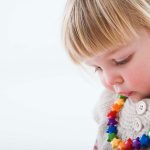 Around this month a turn in communication may occur as others start to understand about 75% of what toddlers are saying without parents or caregivers having to translate. Shorter versions of words, like “-brella” turn into “umbrella.” Words that begin with ‘f,’ ‘s,’ or ‘y’ sound more clear as well (foot, sun, or you, for example). These language improvements also mean that toddlers are ready to be heard! You may notice them repeating questions or statements over and over again until they get a reaction or a response.
Around this month a turn in communication may occur as others start to understand about 75% of what toddlers are saying without parents or caregivers having to translate. Shorter versions of words, like “-brella” turn into “umbrella.” Words that begin with ‘f,’ ‘s,’ or ‘y’ sound more clear as well (foot, sun, or you, for example). These language improvements also mean that toddlers are ready to be heard! You may notice them repeating questions or statements over and over again until they get a reaction or a response.
Little ones also begin using general concepts of time as they now have a basic understanding of the past, present, and future. They can’t yet reference what happened “last Tuesday,” but they may apply “yesterday” to almost anything that happened in the past. If they ask if it’s time to go to the playground and a caregiver says, “We’re going soon,” they start to understand that “soon” is not “right now.” They also apply past events to current conversations. For example, if a cake is mentioned in a bedtime story, they talk about the cake at their cousin’s birthday party.
Around this time toddlers’ movements begin looking more and more like those of a “big kid!” They can throw a tennis ball about 5-10 feet and begin using the trunk of their body to project the ball further. They still need a push to get a swing going, but soon you’ll see them pumping their feet to keep it flowing.
Children at this age are making big strides in self-care. Around age 35 months they can brush their teeth and hair on their own. The act of getting dressed is also improving. They still need help with buttons, but they can pull a shirt or sweater over their head with minimal assistance. Of course, you’ll need to do a quality check to make sure teeth are clean and shirts aren’t on backward!
Remember that children are delightfully unique and some of these milestones will happen before or after this month.
Back







